AVADirect Clevo X7200: Six Cores, SSD RAID, and GTX 480M SLI Yields World's Fastest DTR Notebook
by Jarred Walton on October 7, 2010 12:30 AM ESTLCD Redux
The Clevo X7200 we received for testing uses the same HannStar Display HSD173PUW1 found in 17.3" notebooks like the W870CU, W880CU, and ASUS G73Jh. This is an older LCD using CCFL backlighting, but the good news is you get a great contrast ratio. The not so good news is that the maximum brightness isn't as high as the latest LED backlit displays. We ran the X7200 through our display tests just to confirm there's no major differences from previously tested LCDs (i.e. the G73Jh).
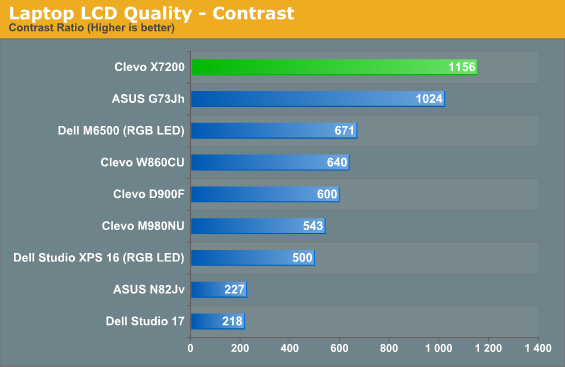
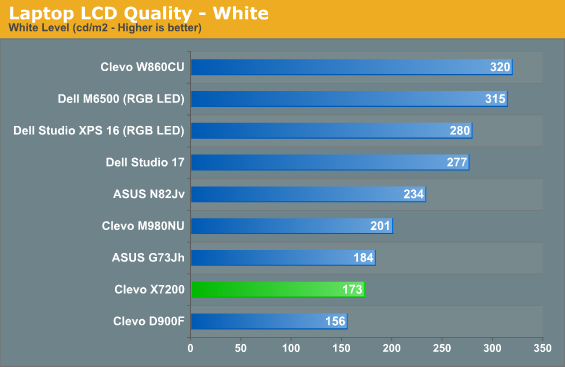
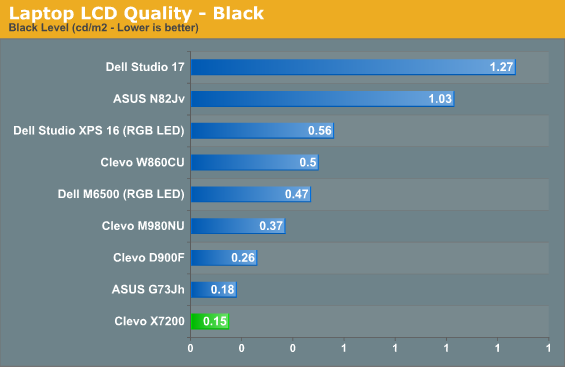
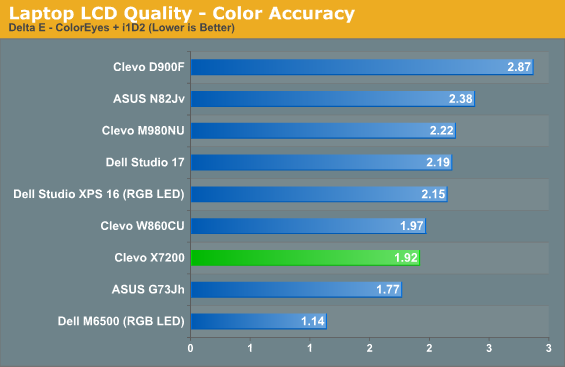
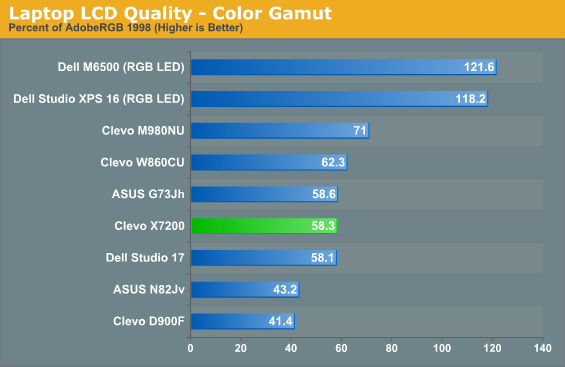
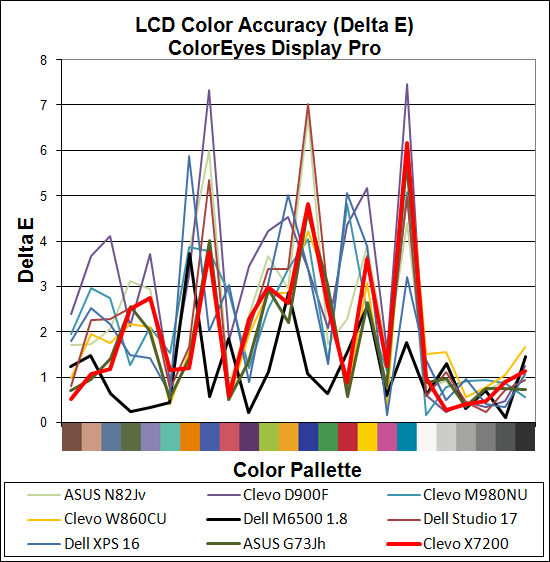

No surprises here: the G73Jh and X7200 results are extremely similar, and any differences we can chalk up to minor variations between panels. The G73 had slightly better color accuracy while the X7200 has a higher contrast ratio. Both have similar gamuts and maximum brightness. While the contrast ratio is lower, the Dell Precision M6500 is easily the best looking panel of this selection. Some will complain that high color gamut displays make images look oversaturated, but I'll take that over the undersaturated 58% gamuts any day of the week. Of course, the RGB LED panels also cost more, but since the X7200 is a premium product we'd appreciate it if Clevo added a truly premium display as opposed to using last year's offerings. (Note that the HannStar panel isn't listed on their site as a current product anymore, likely because it was discontinued a while back.)















38 Comments
View All Comments
Candide08 - Saturday, October 9, 2010 - link
Some companies, like mine, are no longer buying workstations. We are issued "desktop replacement" laptops, like HP 88740W with dual i7 quad cores and 8GB of memory. Throw in Virtual-Box and run one or two other VM's and its workable as a full function portable desktop with 1920 x 1200 screen resolution and a 5.9 Win 7 rating.The 8740W is not quite a spec'd-out as this, but its in the same league.
Yes, its heavy. Yes, the power brick is huge. Yes, I bought a rolling laptop case.
crackedwiseman - Thursday, October 7, 2010 - link
Honestly, why not go for a desktop GPU with those sort of thermals? You could quadfire a mobile Juniper GPU, or use a vanilla, normally binned 5870 and still come in with the same power draw.Meaker10 - Sunday, October 10, 2010 - link
Because:A: It's easier to cool two separate sources of heat.
B: Moduals are of the smaller size are made already with mobile GPUs.
C: Quadfire would take up more space and would suck for efficiency.
D: Desktop drivers do not have some of the mobility options.
E: Mobile 480M crossfire is faster than a single desktop 5870.
rsgeiger - Thursday, October 7, 2010 - link
I forgot if you guys ever got a review unit from Alienware, or are going to in the near future, but a comparison of the dual GPU notebooks out there would be fun to see.Otherwise great review! I really read closely this time the Powerdraw, heat, and noise comparisons. This always the most important buying decision I have when buying DTRs.
JarredWalton - Thursday, October 7, 2010 - link
We looked at the previous generation M980NU with QX9300 and SLI GTX 280M, which is pretty similar to the older M17x. Now M17x is doing up to i7-940XM, with either HD 5870 CF or GTX 285M SLI. (5870 CF is going to be faster than 285M SLI by around 20-25% I think, but no PhysX or CUDA.) Anyway we updated our gaming benchmarks and don't typically have the opportunity to rerun new tests on previous reviews, which is why we focused on comparisons to desktops.You can always get a rough estimate by comparing 3DMarks, but it's pretty safe to say the M17x needs a new revision before it's going to come anywhere near the performance of the X7200. Pricing for a maxed out M17x is currently $3900 without the RAID 0 C300 SSDs, so $5000 total with 5870 CF and 8GB RAM. But you have to look at what you're missing: 480M SLI is quite a big jump from 5870 CF, and the i7-980X is, as I mention in the text, about 50% faster than even the i7-940XM. Alienware does have a much nicer LCD panel, though: 1920x1200 with RGB LED backlighting.
Rasterman - Thursday, October 7, 2010 - link
CPU wise the 980x is 136% faster than the 940xm.http://www.cpubenchmark.net/high_end_cpus.html
5150Joker - Thursday, October 7, 2010 - link
It's not "much faster" than an M17x with 5870m Crossfire + 940xm. If you look at NBR, you'd see that the 480M SLi barely outpaces the 5870s by a mere 500-800 3dmark vantage points. That's basically nothing. When both are overclocked, the X7200 again does not surpass the M17x, they are about even.The biggest advantage the X7200 has is the desktop processor but there's a program called ThrottleStop that allows end users to manipulate TDP/TDC + multiplier settings for the 940xm in the M17x. I've gotten the 940xm as high as 3.8 GHz on all 4 cores (8 threads) so again, the X7200's desktop processor advantage is diminished even if it is 6 cores.
You have to keep in mind the X7200 is severely limited by it's 300W PSU as you discovered so there's no real room for overclocking. One of the first users to purchase the X7200 on NBR discovered that his 480m SLI + 980x setup was shutting off during the Mafia 2 benchmark and he was running the system at stock!
JarredWalton - Thursday, October 7, 2010 - link
I'm out of town now so I can't test other scenarios, but I ran every benchmark several times and the only thing to ever overload the power brick was Furmark. All the other tests I saw topped out at power draws of around 310W, but it's possible some combination could get that higher. I'd like to know exactly what others have seen overload the PSU, though. Note that I did get beta drivers from NVIDIA for testing (260.80 I think -- the WHQL drivers should release "soon" according to NVIDIA), and that might be why I didn't experience other overloads.As for performance comparisons, you can't cite 3DMark Vantage as a meaningful item. I include it as a quick point of reference, but it's not a game and it doesn't really behave like most games. Simply getting GPU PhysX to work should boost the score I posted by 1000 or more, but it's ultimately the games that matter.
For gaming, the X7200 with 480M SLI beats the tar out of everything else in the notebook world. If you had a similar X7200 with HD 5870 CF, the difference would be smaller (thanks to having a fast CPU), but with a large cross section of games it's pretty clear 480M is faster. It's also more power hungry by a large amount, though, so I can understand going the 5870 CF route. It's too bad that the only way to do get 5870 CF is the M17x or Clevo X8100, since that also gives up the desktop CPU and you get areas where you're CPU limited.
Meaker10 - Sunday, October 10, 2010 - link
PhysX scores are not valid results for comparisons.The original intention of the test was for 3rd party physX cards at showing the potential in the future, even then the scores were not valid.
Nvidia twisted this and while it has not been removed, PhysX scores will not appear in comparison searches unless you specifically choose them to. They will never appear in the hall of fame.
Futuremark recommends that reviewers keep PhysX off when using 3dmark to review graphics cards.
silverblue - Thursday, October 7, 2010 - link
Ouch... :) I'd be surprised if mine is over 25lb, though it's hardly a power machine. I'd love to have a play with a 50lb desktop... see if the power/weight ratio is favourable. ;)